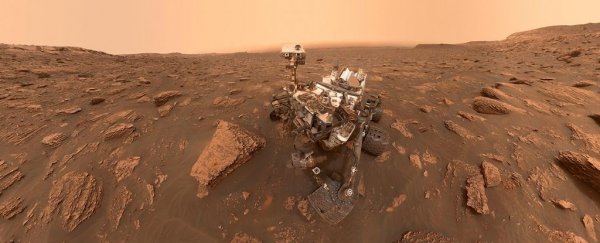Using a new on-board experiment, NASA's Curiosity rover has discovered traces of previously undetected organic molecules on Mars.
None of the organic molecules identified in the sand hold unequivocal signs of life, but they do suggest the new technique, which didn't require the rover to drill, is an effective tool when it comes to searching for evidence of carbon-based molecules, which are important building blocks for life as we know it.
The wet-lab experiment came about after Curiosity hit a figurative bump in the road while looking for signs of life on the red planet at the close of 2016.
Just as the rover was preparing to sample the Martian rock at the base of Mt Sharp, its drill suddenly stopped working.
Instead of putting a break on the mission until the issue could be fixed, researchers at NASA simply changed gears.
Rather than pulverizing rock samples into powder, a bit of loose sand that had already been scooped up on Ogunquit Beach was introduced into Curiosity's 'wet chemistry lab'.
This on-board laboratory includes just nine cups of solvent, which can only be used once each, so researchers have to be really picky about which samples they ultimately choose.
Organic compounds within Martian rock are super challenging to detect, because once they are heated, they break up into simpler molecules.
If these organic compounds, however, react with other chemicals first, they are more likely to enter a gas chromatograph and mass spectrometer for analysis without breaking down. Hence, Curiosity's nine cups of solvent.
It's a cleverly designed system that enables us to quickly analyze soil on Mars from the comfort of our own planet. Yet in late 2016, it had never been put to the test.
The team at NASA didn't expect the sand from Ogunquit to be organic rich, but they weren't sure they could keep drilling on the planet going forward, so it was worth a try.
Breaking the first seal for the Ogunquit sand, researchers found several organic compounds including ammonia and benzoic acid. Some of the organic compounds had never been identified on Mars before.
Now, a couple of years later, the results have been peer-reviewed and published.
As mentioned above, the presence of these organic molecules doesn't definitively mean there was once life on Mars, and no amino-acid derivatives were detected in the sample.
But what's exciting is that this new technique can now be used to look for signs of life, even without the ability to drill.
"This derivatization experiment on Mars has expanded the inventory of molecules present in Martian samples and demonstrated a powerful tool to further enable the search for polar organic molecules of biotic or prebiotic relevance," wrote the NASA research team, led by astrobiologist Maëva Millan from NASA's Goddard Space Flight Center and Georgetown University.
In the end, it took over a year before engineers on Earth were able to fix Curiosity's drill and get it back in action, but by then, we knew the wet chemistry cups could work.
By 2019, the second cup was ready to be used for a sample of clay-bearing rock from further up Mt Sharp. Other analyses are soon to follow, not only on Mars but also on Earth.
NASA plans on conducting a mission in the 2030s to collect the rest of Curiosity's samples, so that they can be more carefully analyzed back on our own planet.
The study was published in Nature Astronomy.
